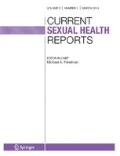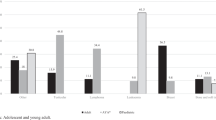Abstract
Purpose of Review
This review summarizes the current literature about sexual and reproductive dysfunction in female cancer survivors and points toward future directions for research.
Recent Findings
Sexual dysfunction is a common condition seen in this population and as the incidence of survivorship grows, so will its prevalence. It is a comorbidity that has a significant effect on the quality of life. While research in this area is emerging, patients are still underserved in both recognition and treatment.
Summary
Research has conclusively shown that female sexual dysfunction after cancer is a major medical issue. Future steps should be taken to educate both medical providers and the public to improve screening and recognition, targeting early treatment with implementation of multidisciplinary care. While several single treatments have shown promise, optimal outcomes will ultimately be achieved through an approach that specifically addresses a patient’s medical, social, and psychological needs.
Similar content being viewed by others
References
Papers of particular interest, published recently, have been highlighted as: • Of importance •• Of major importance
Goncalves P, Groninger H. Sexual dysfunction in cancer patients and survivors #293. J Palliat Med. 2015;18(8):714–5.
Falk SJ, Dizon DS. Sexual dysfunction in women with cancer. Fertil Steril. 2013;100(4):916–21.
• Huffman LB, et al. Maintaining sexual health throughout gynecologic cancer survivorship: a comprehensive review and clinical guide. Gynecol Oncol. 2016;140(2):359–68. This paper provides an overview of sexual dysfunction as it relates to gynecologic malignancy specifically, organized treatment modalities by etiology
• Zhou ES, Falk SJ, Bober SL. Managing premature menopause and sexual dysfunction. Curr Opin Support Palliat Care. 2015;9(3):294–300. This review provides further insight into breast pathology and the link to sexual dysfunction, not often highlighted in other literature
Eisemann N, et al. Quality of life in partners of patients with localised prostate cancer. Qual Life Res. 2014;23(5):1557–68.
Greaves P, et al. Fertility and sexual function in long-term survivors of haematological malignancy: using patient-reported outcome measures to assess a neglected area of need in the late effects clinic. Br J Haematol. 2014;164(4):526–35.
•• Lindau ST, Abramsohn EM, Matthews AC. A manifesto on the preservation of sexual function in women and girls with cancer. Am J Obstet Gynecol. 2015;213(2):166–74. This paper discusses the myths and misconceptions that distance the practitioner from the patient, and provides suggestions to improve the se3xual health of female cancer survivors
Low C, et al. Issues of intimacy and sexual dysfunction following major head and neck cancer treatment. Oral Oncol. 2009;45(10):898–903.
Moreno KF, et al. Sexuality after treatment of head and neck cancer: findings based on modification of sexual adjustment questionnaire. Laryngoscope. 2012;122(7):1526–31.
Reese JB, Shelby RA, Abernethy AP. Sexual concerns in lung cancer patients: an examination of predictors and moderating effects of age and gender. Support Care Cancer. 2011;19(1):161–5.
Mortimer JE, et al. Effect of tamoxifen on sexual functioning in patients with breast cancer. J Clin Oncol. 1999;17(5):1488–92.
Aerts L, et al. Sexual and psychological functioning in women after pelvic surgery for gynaecological cancer. Eur J Gynaecol Oncol. 2009;30(6):652–6.
• Ratner ES, et al. Sexuality and intimacy after gynecological cancer. Maturitas. 2010;66(1):23–6. This article includes a well written section on the role of the patients partner in the overall health of the patient and the relationship
Snell L, et al. Clarifying the expectations of patients undergoing implant breast reconstruction: a qualitative study. Plast Reconstr Surg. 2010;126(6):1825–30.
Li Z, et al. Sexual health in hematopoietic stem cell transplant recipients. Cancer. 2015;121(23):4124–31.
Frey Tirri B, et al. Clinical guidelines for gynecologic care after hematopoietic SCT. Report from the international consensus project on clinical practice in chronic GVHD. Bone Marrow Transplant. 2015;50(1):3–9.
Hirsch P, et al. Female genital chronic graft-versus-host disease: importance of early diagnosis to avoid severe complications. Transplantation. 2012;93(12):1265–9.
Zantomio D, et al. Female genital tract graft-versus-host disease: incidence, risk factors and recommendations for management. Bone Marrow Transplant. 2006;38(8):567–72.
Higgins A, Nash M, Lynch AM. Antidepressant-associated sexual dysfunction: impact, effects, and treatment. Drug Healthc Patient Saf. 2010;2:141–50.
Ford JS, et al. Psychosexual functioning among adult female survivors of childhood cancer: a report from the childhood cancer survivor study. J Clin Oncol. 2014;32(28):3126–36.
Kirchhoff AC, et al. Marriage and divorce among young adult cancer survivors. J Cancer Surviv. 2012;6(4):441–50.
Hill EK, et al. Assessing gynecologic and breast cancer survivors' sexual health care needs. Cancer. 2011;117(12):2643–51.
Park ER, et al. General internist communication about sexual function with cancer survivors. J Gen Intern Med. 2009;24(Suppl 2):S407–11.
• Kohler TS, et al. Results from the survey for preservation of adolescent reproduction (SPARE) study: gender disparity in delivery of fertility preservation message to adolescents with cancer. J Assist Reprod Genet. 2011;28(3):269–77. This article details a survey of attitudes in pediatric oncologists highlighting the deficit in care that female adolescent cancer patients receive, and what is needed to fill this gap
Berman L, et al. Seeking help for sexual function complaints: what gynecologists need to know about the female patient’s experience. Fertil Steril. 2003;79(3):572–6.
Lindau ST, Gavrilova N, Anderson D. Sexual morbidity in very long term survivors of vaginal and cervical cancer: a comparison to national norms. Gynecol Oncol. 2007;106(2):413–8.
Sobecki JN, et al. What we don't talk about when we don't talk about sex: results of a national survey of U.S. obstetrician/gynecologists. J Sex Med. 2012;9(5):1285–94.
• Bober SL, et al. How to ask and what to do: a guide for clinical inquiry and intervention regarding female sexual health after cancer. Curr Opin Support Palliat Care. 2016;10(1):44–54. This study highlights techniques to broach the complex discussion of sexual health and function in this population and provides useful recommnedations for treatment
Kennedy VA, Leiserowitz GS. Preserving sexual function in women and girls with cancer: survivorship is about more than just surviving. Am J Obstet Gynecol. 2015;213(2):119–20.
Rosen R, et al. The Female Sexual Function Index (FSFI): a multidimensional self-report instrument for the assessment of female sexual function. J Sex Marital Ther. 2000;26(2):191–208.
Wiegel M, Meston C, Rosen R. The female sexual function index (FSFI): cross-validation and development of clinical cutoff scores. J Sex Marital Ther. 2005;31(1):1–20.
Rosenberg SM, et al. Treatment-related amenorrhea and sexual functioning in young breast cancer survivors. Cancer. 2014;120(15):2264–71.
Baser RE, Li Y, Carter J. Psychometric validation of the Female Sexual Function Index (FSFI) in cancer survivors. Cancer. 2012;118(18):4606–18.
Flynn KE, et al. Construct validity of the PROMIS(R) sexual function and satisfaction measures in patients with cancer. Health Qual Life Outcomes. 2013;11:40.
Bober SL, Varela VS. Sexuality in adult cancer survivors: challenges and intervention. J Clin Oncol. 2012;30(30):3712–9.
DeSimone M, et al. Sexual dysfunction in female cancer survivors. Am J Clin Oncol. 2014;37(1):101–6.
Rossouw JE, et al. Risks and benefits of estrogen plus progestin in healthy postmenopausal women: principal results from the Women's Health Initiative randomized controlled trial. JAMA. 2002;288(3):321–33.
North American Menopause S. The role of local vaginal estrogen for treatment of vaginal atrophy in postmenopausal women: 2007 position statement of the North American Menopause Society. Menopause. 2007;14(3 Pt 1):355–69. quiz 370-1
Rahn DD, et al. Vaginal estrogen for genitourinary syndrome of menopause: a systematic review. Obstet Gynecol. 2014;124(6):1147–56.
Suckling J, Lethaby A, Kennedy R. Local oestrogen for vaginal atrophy in postmenopausal women. Cochrane Database Syst Rev. 2006;4:CD001500.
Dew JE, Wren BG, Eden JA. A cohort study of topical vaginal estrogen therapy in women previously treated for breast cancer. Climacteric. 2003;6(1):45–52.
Buster JE. Transdermal menopausal hormone therapy: delivery through skin changes the rules. Expert Opin Pharmacother. 2010;11(9):1489–99.
Straczek C, et al. Prothrombotic mutations, hormone therapy, and venous thromboembolism among postmenopausal women: impact of the route of estrogen administration. Circulation. 2005;112(22):3495–500.
Hodis HN, et al. Vascular effects of early versus late postmenopausal treatment with estradiol. N Engl J Med. 2016;374(13):1221–31.
Pinkerton JV, Kagan R. Ospemifene for the treatment of postmenopausal vulvar and vaginal atrophy: recommendations for clinical use. Expert Opin Pharmacother. 2015;16(17):2703–14.
Wierman ME, et al. Androgen therapy in women: a reappraisal: an Endocrine Society clinical practice guideline. J Clin Endocrinol Metab. 2014;99(10):3489–510.
Buster JE. Managing female sexual dysfunction. Fertil Steril. 2013;100(4):905–15.
Barton DL, et al. Randomized controlled trial to evaluate transdermal testosterone in female cancer survivors with decreased libido; north central cancer treatment group protocol N02C3. J Natl Cancer Inst. 2007;99(9):672–9.
Archer DF, et al. Treatment of pain at sexual activity (dyspareunia) with intravaginal dehydroepiandrosterone (prasterone). Menopause. 2015;22(9):950–63.
Segraves RT, et al. Bupropion sustained release for the treatment of hypoactive sexual desire disorder in premenopausal women. J Clin Psychopharmacol. 2004;24(3):339–42.
Derogatis LR, et al. Treatment of hypoactive sexual desire disorder in premenopausal women: efficacy of flibanserin in the VIOLET study. J Sex Med. 2012;9(4):1074–85.
Goldfischer ER, et al. Continued efficacy and safety of flibanserin in premenopausal women with hypoactive sexual desire disorder (HSDD): results from a randomized withdrawal trial. J Sex Med. 2011;8(11):3160–72.
Katz M, et al. Efficacy of flibanserin in women with hypoactive sexual desire disorder: results from the BEGONIA trial. J Sex Med. 2013;10(7):1807–15.
Foster DC, et al. Oral desipramine and topical lidocaine for vulvodynia: a randomized controlled trial. Obstet Gynecol. 2010;116(3):583–93.
Sadownik LA. Etiology, diagnosis, and clinical management of vulvodynia. Int J Womens Health. 2014;6:437–49.
Goetsch MF, Lim JY, Caughey AB. A practical solution for dyspareunia in breast cancer survivors: a randomized controlled trial. J Clin Oncol. 2015;33(30):3394–400.
Belkin ZR, Krapf JM, Goldstein AT. Drugs in early clinical development for the treatment of female sexual dysfunction. Expert Opin Investig Drugs. 2015;24(2):159–67.
Safarinejad MR. Evaluation of the safety and efficacy of bremelanotide, a melanocortin receptor agonist, in female subjects with arousal disorder: a double-blind placebo-controlled, fixed dose, randomized study. J Sex Med. 2008;5(4):887–97.
Gao L, et al. Systematic review and meta-analysis of phosphodiesterase type 5 inhibitors for the treatment of female sexual dysfunction. Int J Gynaecol Obstet. 2016;133(2):139–45.
van Rooij K, et al. Efficacy of testosterone combined with a PDE5 inhibitor and testosterone combined with a serotonin (1A) receptor agonist in women with SSRI-induced sexual dysfunction. A preliminary study. Eur J Pharmacol. 2015;753:246–51.
Carter J, Goldfrank D, Schover LR. Simple strategies for vaginal health promotion in cancer survivors. J Sex Med. 2011;8(2):549–59.
Billups KL. The role of mechanical devices in treating female sexual dysfunction and enhancing the female sexual response. World J Urol. 2002;20(2):137–41.
Billups KL, et al. A new non-pharmacological vacuum therapy for female sexual dysfunction. J Sex Marital Ther. 2001;27(5):435–41.
Schover LR. Sexuality and fertility after cancer. Hematology Am Soc Hematol Educ Program. 2005:523–7. doi:10.1182/asheducation-2005.1.523.
Schroder M, et al. Clitoral therapy device for treatment of sexual dysfunction in irradiated cervical cancer patients. Int J Radiat Oncol Biol Phys. 2005;61(4):1078–86.
Yang EJ, et al. Effect of a pelvic floor muscle training program on gynecologic cancer survivors with pelvic floor dysfunction: a randomized controlled trial. Gynecol Oncol. 2012;125(3):705–11.
Taylor S, et al. Interventions for sexual problems following treatment for breast cancer: a systematic review. Breast Cancer Res Treat. 2011;130(3):711–24.
Laan E, Both S. Sexual desire and arousal disorders in women. Adv Psychosom Med. 2011;31:16–34.
Acknowledgements
Tobias S. Köhler reviewed this manuscript for Current Sexual Health Reports.
Author information
Authors and Affiliations
Corresponding author
Ethics declarations
Conflict of Interest
Neil Chappell and Terri Woodard each declare no potential conflict of interest.
Human and Animal Rights and Informed Consent
This article does not contain any studies with human or animal subjects performed by any of the authors.
Additional information
This article is part of the Topical Collection on Female Sexual Dysfunction and Disorders
Rights and permissions
About this article
Cite this article
Chappell, N., Woodard, T. Sexual and Reproductive Dysfunction in Young Female Cancer Patients. Curr Sex Health Rep 9, 12–19 (2017). https://doi.org/10.1007/s11930-017-0098-1
Published:
Issue Date:
DOI: https://doi.org/10.1007/s11930-017-0098-1




